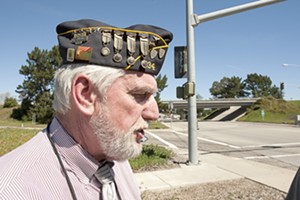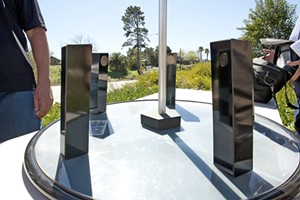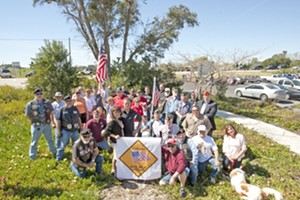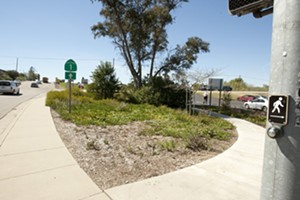
What had started life as a simple Sun photo shoot and interview about a proposed veterans monument at the gateway to Old Town Orcutt had become a massive media event, drawing a crowd of jacketed supporters—many sporting white beards or sideburns—and reporters from other outlets.
The group assembled on a recent Thursday afternoon at a Caltrans park-and-ride lot with a common goal: to voice support for Steve LeBard and the monument project he’d like to erect at the site.
LeBard, president of the Old Town Orcutt Revitalization Association and a veteran Marine who served in Vietnam, brought a model of his proposed monument with him, a 60-inch flagpole surrounded by five miniature pillars, one for each branch of the U.S. military. It sat on a gray folding table, the small cloth flag barely twitching in the breeze created by the cars rushing down Clark Avenue.
The actual monument will boast a 60-foot flagpole when it’s completed—if it’s completed, that is.
Caltrans denied LeBard’s application to build the monument on its land, citing Brown v. California Department of Transportation, which established that the “display of the United States flag constituted expressive activity, within the meaning of the First Amendment.”
In an e-mail to LeBard, Caltrans District 5 Encroachment Permit Engineer Steve Senet wrote: “The concern we have in this situation is that, whether a flag hanging on a bridge, or a monument placed within a park and ride lot, we would be placed in a position of having to permit all forms of expression as encroachments in the right of way if we were to allow yours. As such, the Department has determined that the state highway system is not a forum for public expression except as publicly allowed.”
At the park-and-ride lot, as the American Legion Riders gunned their motorcycle engines—not quite drowning out a brassy recording of “The Star-Spangled Banner” simultaneously blaring through their mounted speakers--LeBard shook his head at the idea of a flag transitioning from a symbol for the nation to political speech.
Bob Bumann, a commander with Orcutt’s American Legion Post 534, said he supports LeBard, as did the other representatives there that day.
“This is not just an Orcutt issue,” Bumann said. “This is a country issue.”
Rick Pushies, commandant with the Marine Corps League’s Coastal Valleys Detachment 1340, which offered to provide long-term maintenance for the monument, did more than offer words of encouragement.
“To say that a veterans memorial cannot fly the flag is a disgrace to every American citizen,” he said. “And I’m pissed.”
Pushies isn’t the only local who feels strongly about the issue, but Caltrans representatives say such ire is misdirected.
“We don’t see this as an issue about the flag, and we’re not going to get into that discussion or debate,” Caltrans District 5 spokesman Jim Shivers told the Sun. “That’s not what this is about. This is about Caltrans, which is following a mandate not to have any messages within the right of way.”
Shivers explained—and reiterated several times—that Caltrans allowing something like this monument would open a floodgate.
“If we approve one, we have to approve all,” he said. “That would include any message on any topic by any group.”
His hope is that, as this story unfolds, people will realize Caltrans’ position.
“We have had many members of our staff that have served in the military, that serve in the reserves today,” he said. “We’re all proud of their service over the years. And we are more than willing to help this group, if we can, to find another location—and if we can help, we would be more than happy to do that.”

LeBard likes the spot he found at the park-and-ride lot. It’s highly visible, it’s at the entrance to the old town, and it can provide plenty of parking if groups want to hold Memorial Day or Fourth of July events there, since the lot is empty on holidays.
Concrete plans
LeBard researched various rules and regulations while designing the monument, including a 1953 state statute that says U.S. or California flags may be displayed on sidewalks in or abutting state highways—as long as they’re properly installed and maintained.
As designed, LeBard’s monument would feature a five-pointed star, the same shape as the stars on the flag, stained or dyed in a 30-foot concrete slab base. Each point would stretch toward a black granite column with a bronze insignia from one of the branches of the U.S. military: Marine Corps, Army, Navy, Air Force, and Coast Guard.
The pillars are all designed to slightly tilt inward, subtly bowing toward the U.S. flag fluttering at the top of a 60-foot anodized aluminum pole.
LeBard designed the monument with longevity in mind. He tracked down the supplier for the flagpole in front of the local Sears, which has stood for decades. The columns would sport 50-watt LED spotlights to illuminate the flag at night, with bulbs that require changing once every decade or two. He lined up local veterans groups to handle upkeep and maintenance.
He also worked to fund the project with help from interested groups. He figured the columns would cost $3,000 apiece, and the bronze insignia each carry a $700 price tag.
OTORA has put up $10,000 for the project, and local military and veterans groups have also dropped serious chunks of change. Pretty much all of the design work, engineering, building costs, and material have been covered or donated.
“It’s been phenomenal how much support we’ve got on it,” LeBard said. “Until it got to Caltrans.”
All or nothing
The Brown v. California Department of Transportation case cited in Caltrans’ denial centered on the U.S. flag. Shortly after the terrorist attacks of Sept. 11, 2001, citizens across the country began draping the stars and stripes from overpasses. Occasionally, people hung other displays as well, including signs reading “At What Cost?” and “Are you Buying the War?”
Two women—Amy Courtney and Cassandra Brown—who hung such signs on Highway 17 in Santa Cruz watched as a police officer removed their messages, but left the nearby flags. The women filed a First Amendment-related action against Caltrans, which maintained that its policy against signs and banners on overpasses didn’t extend to the American flag, because, among other arguments, the flag is an ubiquitous national symbol that doesn’t represent a particular viewpoint.
A district court entered a preliminary injunction against Caltrans’ policy, but the department challenged it. The U.S. Court of Appeals, ninth circuit, tackled the issue, ultimately deciding the women had a “colorable First Amendment claim.”
“The reason the events of September 11th evoked such a spontaneous proliferation of flags is precisely because of its message,” Judge Kim Wardlaw wrote in her opinion. “Americans sought solace in the symbol of a nation joined in the effort to combat terror in the face of tragedy. Indeed, it is the potency of the flag's message that makes CalTrans reluctant to remove it from California's highways. In light of recent world events, that reluctance is laudable; however, the policy derived from it is not.”
In other words, a flag counts as political speech, and Caltrans can’t pick and choose what it allows or tears down. Which brings us to today.
“We’re bound by that court ruling,” Caltrans’ Shivers told the Sun, “which basically says that if we were to allow this particular monument, or this particular fill-in-the-blank … we would then be bound to allow all other monuments, signs, displays to go in, despite the message.

“So, again, we’re looking at it this way: that this is something within the Caltrans right-of-way, it is something we have control over, with safety being the driving force here.”
Shivers added another point: “If we were to allow a proliferation of signs and messages within the right of way, that could obscure other signs—traffic signs, speed limit signs—that the public needs to see so that the state highway system continues to operate in a safe manner.”
LeBard believes his monument should be allowed under all current laws and regulations. He easily calls up details from an incident in which Caltrans inflamed flag-lovers by painting over a mural of a U.S. flag—painted in Alameda County on Highway 680 after 9/11—days before July 4, 2010. Guerilla artists repainted the mural, and various media reports indicated Caltrans officials said they’d leave it up as they worked on a “permanent solution.”
Welcome!
LeBard is calling his monument an Old Town Orcutt Gateway Monument and points to the Caltrans Gateway Monument Program Guidelines that he believes would technically allow his project.
Caltrans didn’t agree with that definition, which typically applies to signs featuring city names. A slideshow at the Caltrans website shows “Welcome to Nevada County” on a boulder, flanked by two rocks with images of men panning for gold. Some of the monuments are simple—a painted sign or lettering on a freestanding wall. Others are more complex; on one sign, the words “Welcome to the Fall River Valley” are painted on a plank above the white-on-blue silhouettes of a woman swinging a golf club, a kneeling figure aiming a rifle into the air, and a man casting a fishing line.
In a denial letter to LeBard, Caltrans Encroachment Permit Engineer Senet wrote: “You may appeal the denial by contacting the District Director in writing.”
LeBard didn’t see that as his best option.
“[Why] sit for months and go through an appeal process to get right back to first base again?” he told the Sun. “I mean, that’s what’s going to happen. I know how bureaucracies work.”
He explained that appeals processes can grind people down until they give up and walk away from their causes. And maybe, he said, that’s the point: “[They] just beat the hell out of you so you can’t accomplish what you set out to do.”
LeBard figured Caltrans wouldn’t change its policy just for him. It might be easier, he figured, to change state law—at least in this case.

Another advocate
State Sen. Tony Strickland’s constituency stretches from Santa Clarita in Los Angeles County to sections of Santa Barbara County. The northernmost chunk of the 19th Senate District includes Orcutt, which puts this monument issue in his camp.
Strickland explained that LeBard’s team contacted his office when they thought they could work with Caltrans to bring the memorial project to fruition.
“We said, ‘Let us know if we could be helpful at any point,’” the senator recalled.
When he learned that Caltrans denied the application, he decided the point had come to get helpful. On March 24, past the deadline to introduce new bills, he amended an existing bit of proposed legislation: SB 443. What once suggested a tweak to Section 104150 of the Health and Safety Code now proposes a special law to allow the Old Town Orcutt Revitalization Association to “plan, construct, and maintain” the memorial—all without any state funds.
Strickland said his dad served in Korea and Vietnam, so issues that impact veterans are near and dear to him.
In 2003, he worked with the 101st Airborne Division Association to name a stretch of the 101 highway—connecting Thousand Oaks to Carpinteria—after the fighters who most famously fought in Normandy and the Battle of the Bulge in World War II. A sign with the division’s feathered insignia declaring “The Screaming Eagles Hwy” now stands near an aged bell indicating the Historic El Camino Real route and an adopt-a-highway sign for Bahai Faith.
[image-5]
“Honoring our veterans is important,” Strickland told the Sun.
(Caltrans’ Shivers explained that the highway memorial dedication sign program is a different animal, involving strategic placement with input from experts. “The location is under careful review by our traffic safety engineers,” he said.)
On March 31, Strickland explained that SB 443 would next head to the rules committee to determine where to refer it in the complex web through which bills pass on their way to become laws (remember School House Rock?). If it hit the right notes, it would then go to the floor, then to the Assembly. Even with smooth sailing, this can be a seven- or eight-month process.
Strickland’s office reported on April 4 that the bill had received its first referral, to the Senate Veterans Affairs Committee. The hearing is set for April 12, and LeBard said he’ll be testifying in Sacramento that day.
The senator is hopeful: “I don’t see why anybody would be against this.” He said honoring veterans is a worthy goal, one that can spark interest in younger generations to research the people who fought for the freedoms we have today.
“The least that we can do is have memorials and things for people who served,” he said.
So what will Caltrans do if the bill passes through its necessary hoops?
“You know, we always act in a spirit of cooperation with all of our partners, and that includes lawmakers and members of the community,” Shivers said. “At the end of the day, we’re looking for mutually acceptable and agreeable solutions, and we’ll react to any legislation accordingly.”
And it the bill doesn’t pass? LeBard sent the Sun an e-mail explaining his position in that case:
“Caltrans has an annual budget of $14 billion. Caltrans has a staff of 140 attorneys and 100 investigators, paralegals, secretaries, claims officers, and administrative personnel. Caltrans is the only state office that handles all its own legal affairs. The office is regarded as the nation’s premier government transportation legal office.
“If I lose to Caltrans it will be a sad day in California’s history and a sad day for every patriot in the United States of America. I will not lose. The most important thing that we can entrust in our children’s heritage is patriotism.”
Contact Executive Editor Ryan Miller at [email protected].








